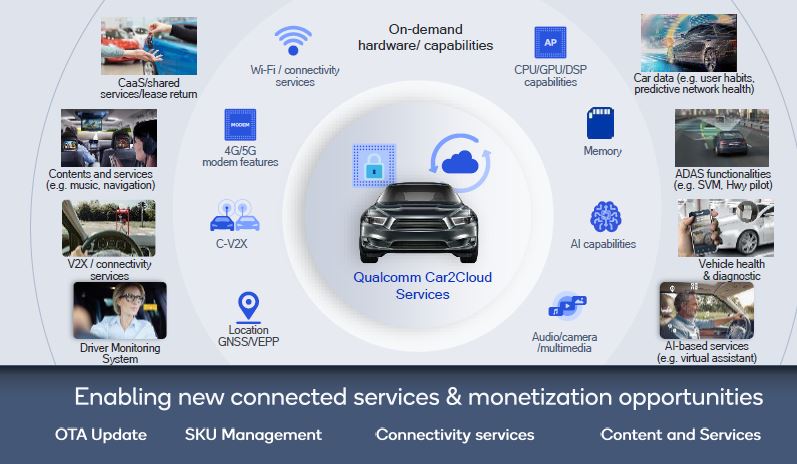Modern lives have become increasingly connected, and cars are no exception. During road trips and daily work commutes, cars have become an extension of drivers’ smartphones—and, increasingly, computers on wheels. Historically, the car’s value depreciates the moment it is driven off the lot, but cloud technology is upending that status quo, future-proofing cars for owners while simultaneously creating new revenue streams for automakers, wireless telecommunications companies, and even entertainment brands.
For automakers and OEMs, understanding consumer demand is crucial to reaping the full value of these revenue streams and retaining customers. As the automotive industry continues its digital transformation, consumers will expect their cars to be no different than other computing devices, enabling seamless, wireless connected experiences even while they are on the road. It is no surprise that the most desired features for car buyers today include navigation systems, app services, and other in-vehicle entertainment features, and the desire for these features can be strong enough to convince buyers to switch auto brands. Today, as many adapt to more digital lifestyles, consumers are purchasing fewer vehicles over their lifetimes and proving more likely to turn to automakers that can create reliable and customisable digital car experiences.
The transformation of cars into smartphones
Accelerated deployments of 5G networks and connected infrastructure innovations, such as cellular vehicle-to-everything (C-V2X) technology, have created a perfect opportunity for companies to reimagine and seamlessly digitise a customer’s daily transportation journey. Cars have become increasingly complex, with more functionality, software, and features to support autonomy, connectivity, electrification, and shared mobility. New cars can connect to LTE and 5G wireless networks, enabling smartphone-style over-the-air software updates and app downloads.
Consumers are purchasing fewer vehicles over their lifetimes and proving more likely to turn to automakers that can create reliable and customisable digital car experiences
This change has added complexity to the customer’s choice of cars and features. Automakers must now consider the types of services that can be bundled with the car while providing consumers more choices for upgrades. They should expect to face increased challenges, including managing an expanding list of competitive, ‘must-have’ digital functionalities while developing their own differentiated software and hardware offerings.
Automakers, wireless companies, and entertainment brands
The rise of media streaming services such as Netflix and Spotify has created an inflection point, giving automotive companies an unlimited opportunity to develop digital products that will advance the in-vehicle experience for both drivers and passengers. Automakers, connectivity developers, and entertainment companies must work together to create cohesive suites of products for enabling secure services—entertainment subscriptions, navigation, and driver assistance. Services can help car manufacturers improve value, offer superior user experiences, and create service revenue opportunities throughout each stage of a vehicle’s lifecycle as customers unlock additional features or purchase new applications. Automakers must also be strategic about their partnerships, prioritising work with mobile network providers and technology partners who will provide reliable global connectivity and bundled data for services, ensuring a smooth user experience.
The impact of changing consumer behaviour on revenue streams
Traditional automotive lifecycles have long development times; features and hardware capabilities are cemented early in the design phase, and vehicles consequently become outdated shortly after purchase. To retain customers, companies need to provide customisable experiences that fit individual needs. Today’s consumers approach the car purchasing process with a long-term mindset, in some cases circumventing dealerships by going directly to automakers, and trading in their cars every six to eight years rather than every three to five years, as was previously common. The desire for customisation has decreased brand loyalty among customers who are prioritising a modern driving experience. As a result, automakers are finding it more difficult to retain customers.
Over-the-air (OTA) updates offer a streamlined, affordable way to offer these personalised features. As a fast and affordable way to provide customisation to consumers, OTA updates allow people to pay for features on demand, ranging from enhanced telematics and infotainment solutions to safety features such as driver assistance technologies. Automakers can now evolve a vehicle’s software and unlock hardware features over time, using existing hardware to add personalisation options, making cars more valuable to users than the day they were purchased.

Cloud updates in the vehicle, such as Qualcomm Technologies’ Car-to-Cloud (C2C) Platform, is crucial for supporting OTA upgrades. An internet connection provides a stream of data that companies can analyse to bring customers the latest features—ones that were traditionally only available when purchasing new cars. Companies may use in-vehicle data to identify key trends, optimise user experiences, troubleshoot issues, and target/segment customers for new services, applications, and content offerings, ultimately extracting value through continuous engagement with consumers.
Additionally, C2C connectivity empowers vehicles to include app stores, lowering customers’ upfront investments, and potentially enabling additional savings down the line for both companies and car buyers. Hardware, firmware, and software bundles eliminate the need to install these features when the car leaves the lot. App stores combined with subscription data plan packages will provide an ongoing flow of revenue throughout the car’s lifetime.
Prioritising digital experiences
There is a pressing need for automakers to build digital capabilities into their vehicles to enable cloud connectivity. McKinsey & Company reported that the auto-retail experience will fully become digital by 2030—customers are already thinking digital the second they consider buying a car. There is a tremendous opportunity for the vehicle cloud market to grow, potentially generating huge revenue increases for automakers. Profiting from these incredible opportunities will require automakers to take the next steps: developing innovative in-car digital offerings with trusted partners, then securing customers for the long term with compelling, constantly connected in-car experiences.
About the author: Nimish Shrivastava is Senior Director of Product Management at Qualcomm Technologies, Inc.
